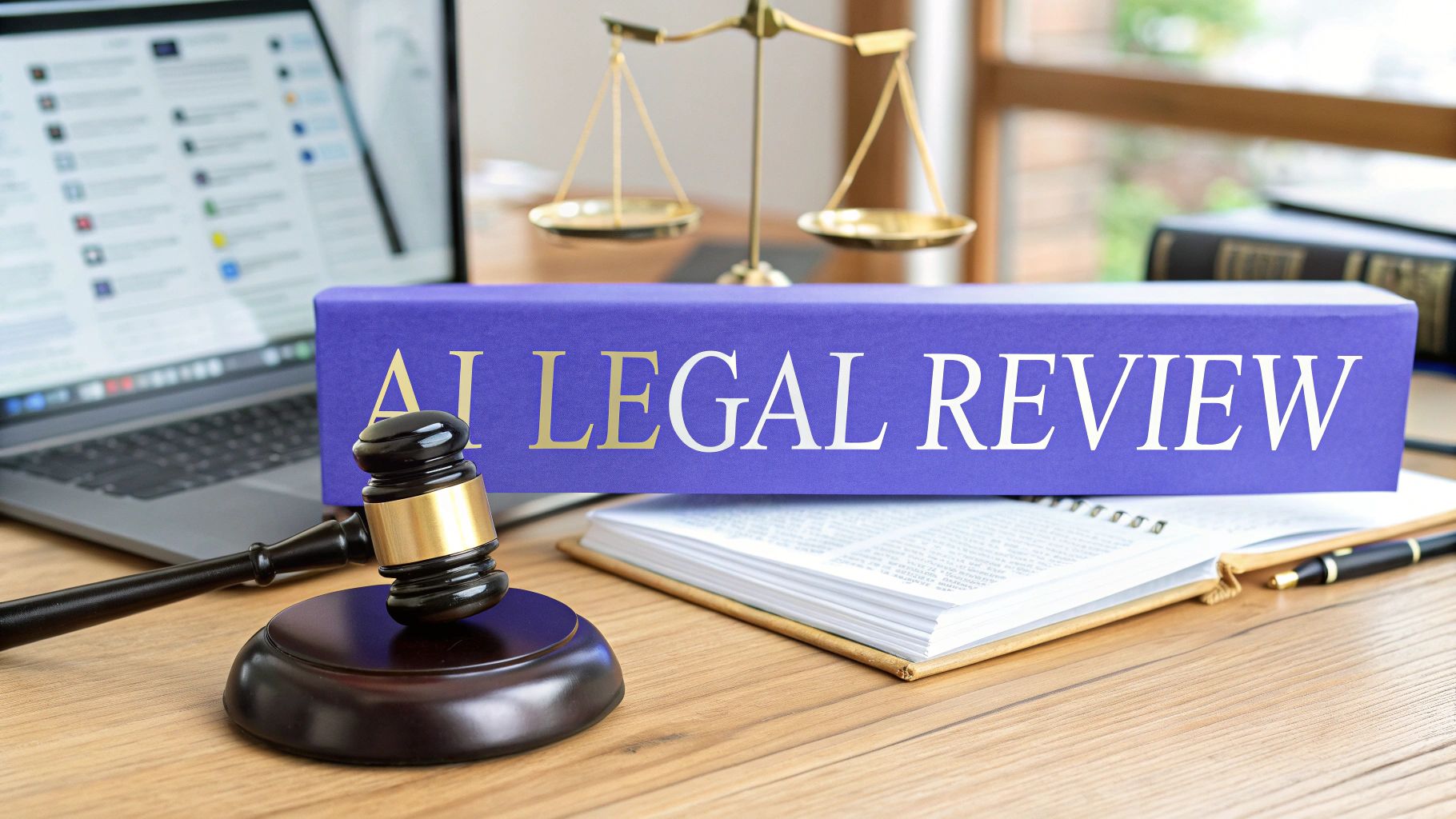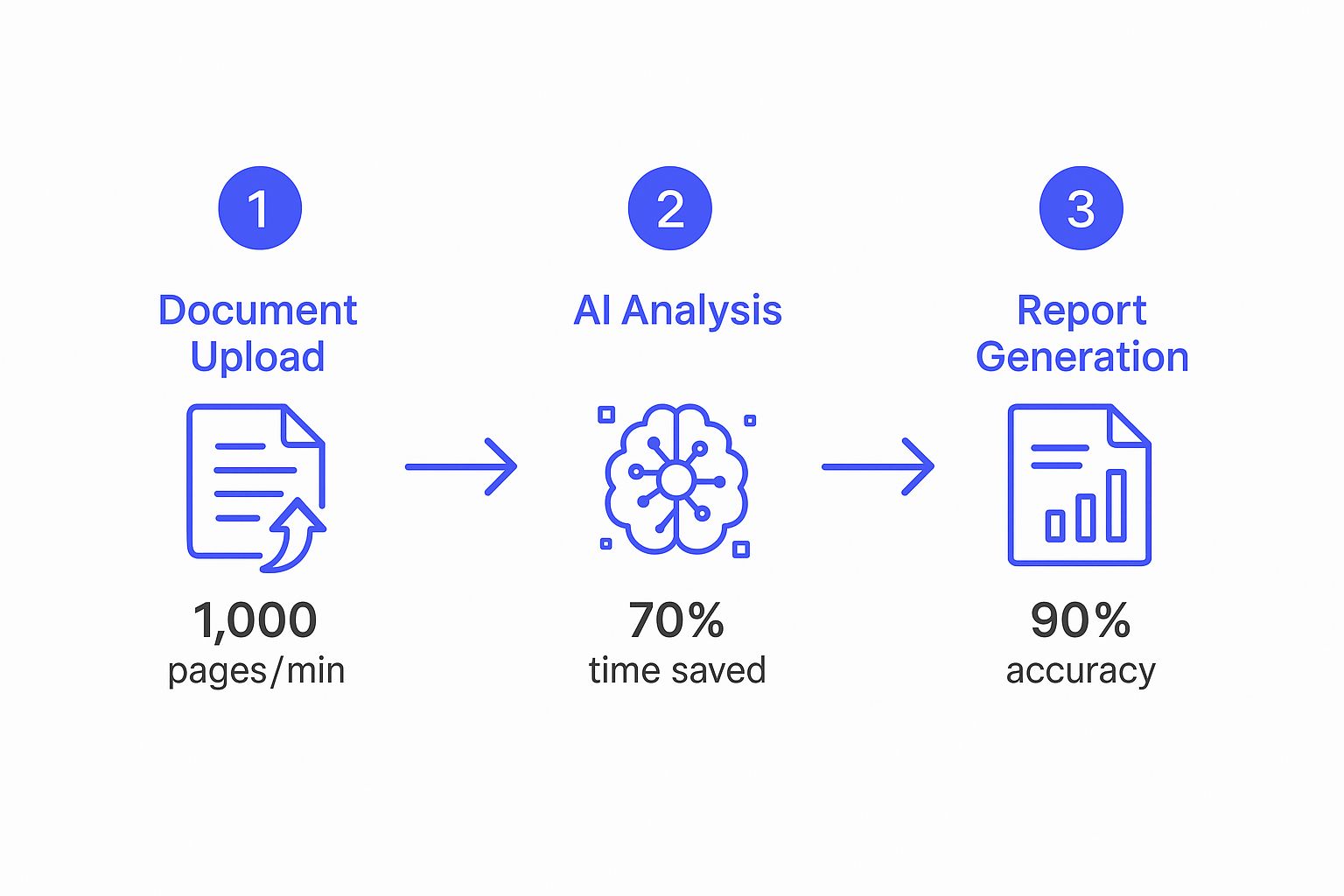
AI legal document review is just what it sounds like: using artificial intelligence to quickly analyze, sort, and pull key information out of legal documents. It’s a complete shift away from the old manual process, leaning on tech like machine learning and natural language processing to get the job done faster and with greater accuracy.
The New Standard for Legal Document Review
Imagine trying to find one specific sentence hidden somewhere in a million-book library—by hand. For decades, that’s pretty much what legal document review felt like. It was a painful, slow, and expensive process, and human error was always a risk.
Junior associates and paralegals would burn the midnight oil for countless hours, digging through mountains of paperwork just to find a single, crucial piece of evidence. The sheer volume of documents in modern litigation or due diligence is just staggering, often leading to blown deadlines and ballooning costs. Worse, the risk of a tired paralegal overlooking something critical could jeopardize an entire case or sink a major deal.
The Shift From Manual to Automated Analysis
This is exactly where AI legal document review steps in. It's not some far-off concept; it’s the solution reshaping the legal field right now. Think of AI as a brilliant, tireless librarian who can instantly read, understand, and categorize every single document you have.
This technology automates the grueling task of analyzing contracts, emails, and discovery documents. It uses smart algorithms to recognize patterns, concepts, and context, allowing it to pinpoint key clauses, flag potential risks, or pull out important names, dates, and locations far faster than any human ever could.
This isn't just a small upgrade—it's a fundamental change in how legal work gets done. By automating the most repetitive parts of document analysis, AI frees up legal professionals to focus on what really matters: strategy, client service, and building a winning argument.
Core Technologies Driving the Change
The power behind AI document review isn’t magic. It’s a combination of powerful technologies working together. The two most important are:
- Natural Language Processing (NLP): This lets the software understand the nuances of human language. It goes way beyond a simple keyword search to grasp complex legal jargon and the context behind the words.
- Machine Learning (ML): The system gets smarter over time. The more documents it reviews, the more accurate it becomes. You can even train it to spot specific clauses or issues relevant to your case.
Understanding these tools is key, as this evolution is a huge part of the future of legal technology and how it’s affecting law practices of all sizes. This jump forward is setting a new standard where efficiency and precision aren't just goals—they're the baseline.
How AI Understands Legal Documents
To really get what AI legal document review can do, it helps to pop the hood and see how the tech actually works. It isn’t magic; it’s a smart, multi-step process that turns dense legalese into structured, understandable information. Think of it like a master chef turning a pile of raw ingredients into a five-star meal.
The process kicks off by gathering all the necessary components. The AI platform takes in thousands of pages of documents, which can be anything from PDFs and Word files to scanned images of paper contracts. Just like a chef sourcing ingredients, the AI collects the raw material it needs to get started.
Preparing Documents for Analysis
Before any real analysis can happen, the documents have to be made machine-readable. Many legal files are just scanned images—to a computer, that’s a picture, not text. This is where Optical Character Recognition (OCR) comes in.
OCR technology scans the image of a document and converts it into digital, searchable text. This step is critical. It transforms a static picture of words into a dynamic dataset that the AI can actually read, making every single clause, sentence, and word accessible for what comes next.
The Core Engine: Natural Language Processing
Once the documents are digitized, the "cooking" really begins. This is where Natural Language Processing (NLP), a field of artificial intelligence, does the heavy lifting. NLP is what allows the software to understand the meaning and context behind human language, not just spot keywords.
For example, a simple keyword search for "termination" would pull up every instance of that word. An NLP model, on the other hand, understands the difference between a "termination for cause" clause and a discussion about the "termination of the agreement's initial term." It grasps the subtle relationships between words and legal concepts.
This infographic breaks down the streamlined process, showing the efficiency gains at each step from upload to final report.

As you can see, the AI turns a high-volume, manual slog into a fast, automated workflow with clear improvements in speed and accuracy.
Advanced NLP models are trained on massive datasets of legal documents. This training allows them to recognize and categorize specific legal elements with impressive precision.
- Clause Identification: The AI can pinpoint specific clauses—like indemnification, limitation of liability, or confidentiality—no matter how they’re worded.
- Entity Extraction: It automatically identifies and pulls out key entities like party names, dates, dollar amounts, and governing jurisdictions.
- Sentiment and Risk Analysis: More advanced systems can even analyze the tone of the language to flag potentially ambiguous or high-risk provisions that need a human eye.
By understanding context, an AI legal document review platform moves beyond simple text matching. It interprets the intent and implications of legal language, providing a level of analysis that was previously only possible through painstaking manual effort.
Machine Learning and Continuous Improvement
The final layer of intelligence comes from machine learning (ML). ML algorithms allow the AI system to learn and get better over time. As it processes more documents and gets feedback from human reviewers, its accuracy in identifying clauses and assessing risk improves.
Think of it as an apprentice lawyer who gets sharper with every contract they review. The system learns from patterns in the data to make increasingly accurate predictions. For instance, if a user consistently flags a certain type of non-standard payment term as high-risk, the ML model will learn to automatically flag similar clauses in future documents.
This continuous learning cycle is what makes AI such a powerful long-term solution. The system adapts to your specific needs and becomes a more valuable partner with each use.
Presenting Actionable Insights
Finally, the AI "plates the meal" by presenting its findings in a clear, usable format. Instead of just giving you a wall of text, a platform like Legal Document Simplifier organizes the extracted information into an interactive dashboard.
Key findings are often displayed through:
- Summarized Key Terms: A plain-language summary of the most critical obligations, dates, and financial commitments.
- Risk Alerts: Clear notifications for non-standard clauses or potentially unfavorable terms.
- Data Visualization: Charts or tables that show the distribution of certain clauses across a portfolio of contracts.
This final step is what makes the technology so practical. It translates complex analysis into actionable insights, empowering you to make faster, more informed decisions without getting lost in legal jargon. The AI doesn't just read the document; it helps you understand what it actually means for your business.
The Big Wins With AI-Powered Review

It’s one thing to know how AI can read a legal document. It's another thing entirely to understand why that should matter to your business. Bringing in AI legal document review isn't just a tech upgrade; it’s about gaining real-world advantages that strengthen your bottom line and sharpen your competitive edge.
These benefits really boil down to four game-changing pillars: incredible speed, better accuracy, serious cost savings, and a true strategic advantage. Each one directly solves a headache that’s long been part of the manual review process, turning a time-consuming chore into a powerful asset.
Unprecedented Speed and Efficiency
The first thing you’ll notice is the speed. It’s staggering. A manual review that could tie up a team of paralegals for weeks can be knocked out by an AI platform in just a few hours—sometimes even minutes. This isn't just a small step up; it’s a giant leap forward for project timelines.
Think about the due diligence for a potential company acquisition. Manually combing through thousands of contracts to find liabilities or change-of-control clauses is a massive undertaking. An AI tool can scan that entire dataset, flag every relevant clause, and generate a summary report before a human reviewer has even finished their first cup of coffee.
This speed creates a positive ripple effect across the board:
- Faster Deals: M&A transactions, real estate closings, and contract talks all move at a much quicker pace.
- Quicker Case Prep: Litigation teams can get through discovery documents in a fraction of the time, letting them build their case strategy that much faster.
- Instant Answers: Need to know something specific from your contract portfolio right now? You can get an answer almost instantly, allowing for nimble, confident decisions.
Enhanced Accuracy and Consistency
Humans are fantastic at strategy and creative thinking, but we’re not machines built for monotonous, repetitive tasks. Fatigue, boredom, and even unconscious bias can creep in during manual reviews, leading to costly mistakes. One missed clause or misinterpreted term can have huge financial or legal fallout.
AI, on the other hand, never gets tired or distracted. It applies the exact same level of scrutiny to the 10,000th document as it does to the first. This consistency takes human error out of the equation during the initial review phase, delivering a much higher standard of accuracy, especially with enormous volumes of documents. The tech is especially good at catching tiny variations in language that a person might easily miss.
By taking human fatigue and bias out of the picture, AI creates a dependable foundation of accuracy. It guarantees every document is checked against the exact same rules, resulting in a consistent and defensible review process.
This isn't just a legal-sector phenomenon. Other fields are using similar tech to conquer massive document loads. For example, an AI tool for literature review can save researchers weeks of work by quickly summarizing and organizing academic papers. The core idea is the same: use technology to tame the document beast.
Significant Cost Reductions
The financial case for AI is impossible to ignore. Traditional document review is all about billable hours, which can quickly balloon into tens or even hundreds of thousands of dollars on big projects. By automating the most time-consuming parts of the job, AI slashes the number of human hours needed.
This allows companies and law firms to shift their legal budgets away from tedious manual work and toward high-value strategic advice. One major study found that AI-powered review can lead to a jaw-dropping 99.97% cost reduction compared to old-school methods. This isn't just a theoretical number; it shows up as smaller legal bills and more predictable project budgets.
Suddenly, top-tier legal review of documents is no longer just for the big players; it's becoming accessible for businesses of every size.
Gaining a Powerful Strategic Edge
This might be the most crucial benefit of all. When you free up your best people—your lawyers and executives—from the drudgery of manual review, you unlock their true potential. They can finally dedicate their time and expertise to the work that actually drives the business forward.
This reclaimed time can be poured into what really matters:
- Developing Case Strategy: Focusing on the subtle points of a legal argument instead of just searching for keywords.
- Negotiating Better Deals: Walking into negotiations with a complete, data-backed understanding of every clause and risk.
- Advising Clients and Leadership: Offering proactive, high-level guidance built on insights pulled directly from document analysis.
At the end of the day, an AI legal document review platform like Legal Document Simplifier helps your team work smarter, not just harder. It transforms document review from a reactive, expensive chore into a proactive, strategic tool that helps you achieve better results and sustainable growth.
AI Document Review in Real-World Practice
The theory behind AI is one thing, but its real value shines when you apply it to the high-stakes, deadline-driven world of legal work. Across different specialties, AI legal document review isn't some futuristic idea anymore. It's a practical tool that’s delivering real results and making workflows better.
Crushing eDiscovery Workloads
One of the biggest wins for AI is in eDiscovery. Picture a massive corporate lawsuit with millions of emails and files. The old way involved an army of attorneys and paralegals manually digging through a digital mountain—a process that was both incredibly expensive and full of human error.
AI completely changes the game. It can chew through millions of documents in a tiny fraction of the time, using smart algorithms to find and flag relevant files. The system even learns from an attorney's feedback, getting smarter and more accurate at finding that crucial "smoking gun" evidence.
Speeding Up Mergers and Acquisitions
The high-pressure world of Mergers & Acquisitions (M&A) offers another perfect use case. During due diligence, the buyer’s legal team has to comb through the target company’s contracts to spot hidden liabilities, like nasty change-of-control clauses or brewing legal fights.
It’s always a race against the clock. An AI platform can scan thousands of contracts in a flash, flagging risky or weird terms that need a human eye. Instead of spending weeks on manual review, lawyers get a quick overview of potential deal-breakers, letting them focus on negotiating and managing risk. That kind of speed can make or break a deal.
Taming Contract Lifecycle Management
Beyond one-off projects, AI is becoming a must-have for day-to-day Contract Lifecycle Management (CLM). Big companies juggle thousands of active agreements, from sales contracts to vendor deals. Trying to manually track every obligation, renewal date, and compliance rule is a recipe for disaster.
An AI-powered system automates all of it. It pulls out key data—like renewal deadlines, payment terms, and confidentiality rules—and puts it all into a searchable dashboard.
The platform acts like a vigilant watchdog, sending automated alerts for upcoming deadlines or flagging contracts that don't match company policy. This proactive approach cuts down on risk and makes sure no critical obligation ever slips through the cracks.
This level of automation is fast becoming the new standard. While law firms have been a bit slower to adopt new tech, in-house legal teams are embracing it much more quickly.
AI Adoption Trends in Legal Departments
This table illustrates the difference in AI adoption rates between law firms and in-house corporate legal teams, highlighting where the technology is being embraced most rapidly.
| Legal Practice Type | AI Adoption Rate |
|---|---|
| In-house Corporate Legal Teams | 42% |
| Law Firms | 18% |
The gap shows that corporate legal departments, often facing immense pressure to improve efficiency, are leading the charge in using AI to manage their document workloads.
In fact, a global survey from the 2025 Thomson Reuters Future of Professionals Report found that 77% of legal professionals are already using AI for document review. The same report noted that these tools can save lawyers about 240 hours per year, freeing them up for higher-value strategic work. You can read the full report on the transformation of the legal industry to learn more.
Aiding Complex Litigation
Finally, in litigation support, AI helps legal teams make sense of massive document dumps to build a strong case. The technology can quickly identify key people, create event timelines, and find hidden links between documents that a human might easily miss.
By giving lawyers a structured and complete view of the evidence, AI helps them build stronger, data-driven arguments. To dig deeper into this, check out our guide on conducting legal document review online. From eDiscovery to M&A, AI is proving itself to be an indispensable ally in the real world of legal practice.
Choosing the Right AI Review Solution

So you see the power of using AI for legal document review. That’s the first step. The next, and arguably more important, is picking the right platform for your team. With more and more options hitting the market, this decision requires a thoughtful approach that balances technology, security, and day-to-day usability.
Making the right choice means looking past the flashy features and focusing on the core capabilities that will actually add value to your workflow. You need to evaluate potential solutions against a clear set of criteria, making sure the tool you choose is not just powerful, but a perfect fit for your team.
Core Evaluation Criteria for AI Tools
When you start comparing AI solutions, it’s easy to get lost in a sea of technical jargon. To cut through the noise, just focus on these four critical areas. They’ll ultimately determine whether the platform becomes a long-term asset or just another piece of shelfware.
Model Accuracy and Reliability: How well does the AI actually understand legal language? The best platforms are trained on massive, high-quality legal datasets. This allows them to accurately identify clauses, pull out key terms, and flag risks with very few errors. Don’t be afraid to ask vendors for their accuracy metrics or case studies.
Ease of Use: A powerful tool is useless if your team finds it too clunky to use. Look for a clean, intuitive interface that doesn’t require a week of training to master. It should be simple to upload documents, see the analysis, and find what you need in a couple of clicks.
Security and Confidentiality: You’re handing over incredibly sensitive client data. Any vendor you consider must have rock-solid security protocols. We’re talking end-to-end encryption, secure cloud storage, and compliance with standards like SOC 2 or GDPR. This is non-negotiable.
Integration Capabilities: The AI tool needs to slide into your existing tech stack, not blow it up. Check if it integrates smoothly with your current legal document management system, CLM platform, or other software you rely on every day. You can learn more about this in our guide on the benefits of a legal document management system.
Planning for Successful Implementation
Choosing the software is only half the battle. Getting your team on board is the other half. Even the best technology will fail if people aren't prepared for the change, which is why a strategic rollout is so important.
The human element is everything. Legal professionals are trained to be meticulous and risk-averse, so introducing a new way of working requires clear communication and a lot of support. The best way to overcome resistance is to show them how the tool makes their jobs easier and build their confidence through hands-on experience.
Key Insight: A successful AI implementation isn't just a tech project—it's a change management initiative. The goal is to empower your team with a tool that helps them, not to replace their expertise.
A pilot program is an excellent way to start. Pick a small, well-defined project and a few tech-savvy team members to test the platform. This lets you iron out any kinks in a low-risk environment, get valuable feedback, and create internal champions who can advocate for the tool's benefits to the rest of the team.
From the very beginning, set clear metrics to measure your return on investment (ROI). You’ll want to track key performance indicators like:
- Time Saved: Compare how long document review takes before and after implementing the AI solution.
- Cost Reduction: Calculate the savings in billable hours or fees for outside counsel.
- Accuracy Improvement: Monitor how often errors or missed issues are reduced compared to purely manual review.
Navigating the Growing AI Adoption Landscape
The use of AI in the legal field is definitely on the rise, but it's not happening at the same pace everywhere. Ironclad's 2025 State of AI Report, which surveyed 800 legal practitioners, found that while overall AI adoption reached 69%, there's a big difference between practice types.
Corporate legal departments are really leading the charge with an 81% adoption rate, while law firms lag behind at 55%. That 26-point gap suggests in-house teams are moving much more aggressively to adopt tools for tasks like AI legal document review.
This trend just underscores how important it is to make an informed decision when picking a tool. To get a wider perspective and explore various AI tools and solutions on the market, checking out a dedicated AI tools blog can provide great insights and comparisons. Making a confident choice helps your organization not just keep pace, but actually gain a competitive edge.
Common Questions About AI in Legal Review

Adopting any new technology comes with a learning curve and a healthy dose of skepticism. When that tech touches something as sensitive as legal work, the questions get even more pointed. Getting clear, direct answers is the only way to move forward with confidence.
Let's cut through the noise and address the most common concerns legal pros have about AI legal document review. We'll demystify the technology so you can see exactly how these tools fit into a modern legal practice.
Is AI Legal Document Review Secure and Confidential?
This is usually the first question—and for good reason. The answer is a firm yes. Leading AI legal tech platforms are built from the ground up with security as the top priority. They know they're handling incredibly sensitive client information and use enterprise-grade measures to protect it.
These protections aren't just an afterthought. They typically include:
- End-to-End Encryption: Your data is scrambled from the moment you upload it to the time it's stored, making it unreadable to anyone without authorization.
- Secure Infrastructure: Platforms rely on trusted cloud providers that have robust physical and digital security protocols in place.
- Compliance Standards: Reputable vendors adhere to strict standards like SOC 2 and GDPR, which demand regular, rigorous audits of their security practices.
Your client data remains isolated and protected. Still, it's always smart to verify a provider’s specific security credentials during your evaluation to make sure they meet your firm's standards for confidentiality.
Will AI Replace Lawyers in Document Review?
The short answer is no. AI is a powerful assistant, not a replacement for a lawyer's expertise. Its real job is to automate the high-volume, repetitive tasks that eat up valuable time—the very work that often leads to burnout and costly human error.
Think of it this way: AI does the first, exhaustive pass through thousands of documents, finding and organizing the relevant information. This frees up lawyers to apply their critical judgment, strategic thinking, and client counseling skills to that organized data. Those are uniquely human abilities that AI simply can't replicate.
The ideal relationship is collaborative. AI enhances a lawyer's efficiency and analytical power, allowing them to focus on the high-value strategic work that wins cases and closes deals.
This shift allows legal professionals to deliver more strategic value, which is exactly what clients are looking for.
What Is the Learning Curve for an AI Review Tool?
Gone are the days of clunky, complicated software that felt like you needed a data science degree to operate. Modern AI legal platforms are designed with lawyers in mind. They feature intuitive, user-friendly interfaces that make it easy to get started with minimal training.
Good vendors know that successful adoption hinges on user comfort. They typically provide a suite of support resources to get your team up and running fast.
- Comprehensive Onboarding: A guided setup to smoothly integrate the tool into your existing workflow.
- Team Training Sessions: Hands-on instruction to make sure everyone feels confident using the platform.
- Ongoing Support: Easy access to experts who can answer questions as they come up.
Many firms find success by starting with a small pilot project. This approach lets the team get comfortable with the tool and see its value firsthand in a low-stakes environment, which helps build momentum for a wider rollout.
How Does AI Handle Complex Legal Language?
This is where advanced AI models really shine. A simple keyword search can easily miss context, but modern AI uses Natural Language Processing (NLP). NLP models are trained on massive datasets of legal documents, which allows them to understand the nuance, context, and intent behind complex legal clauses.
For instance, an AI can tell the difference between a clause discussing "termination for cause" and another mentioning the "termination of an agreement's term." It gets that the same words can have wildly different meanings depending on their context.
While no system is perfect, AI can consistently flag ambiguous or non-standard language for an expert human to review—a critical task where even the most diligent lawyer can stumble from fatigue after reading hundreds of pages.
Ready to see how an AI-powered platform can simplify your document review process? Legal Document Simplifier instantly transforms complex legal agreements into clear, actionable summaries. Save time, reduce risk, and make more informed decisions by visiting https://legaldocumentsimplifier.com to get started.